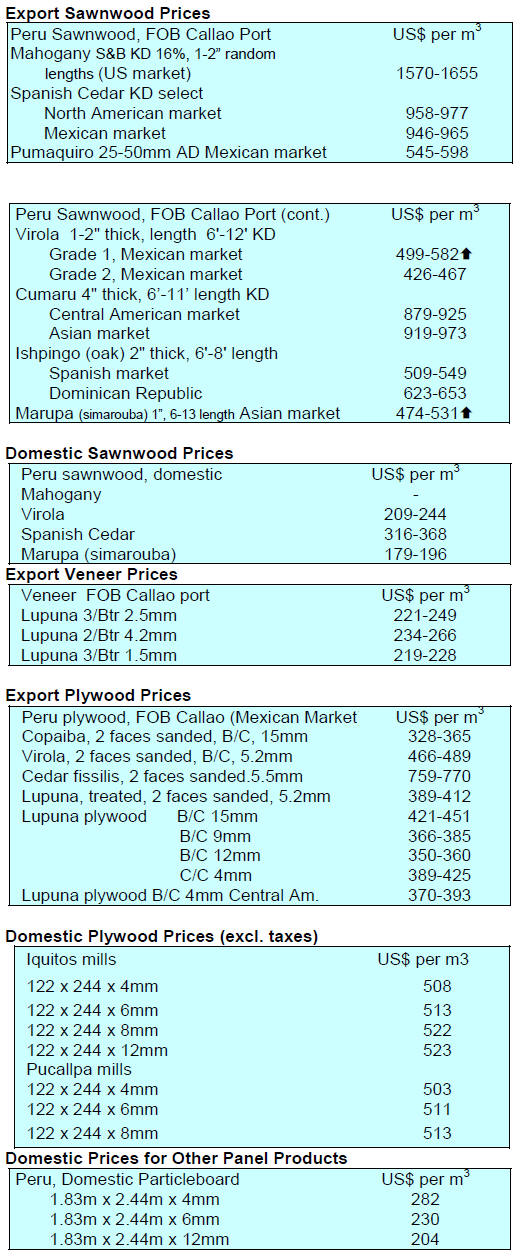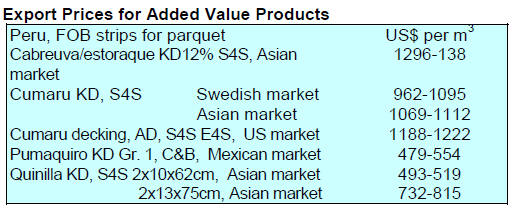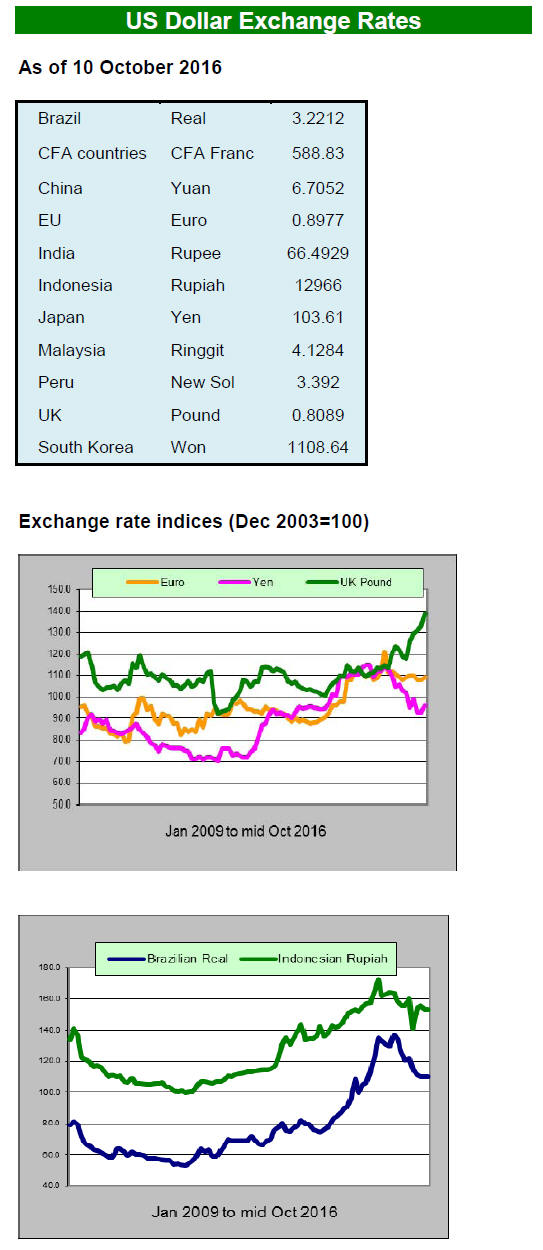2. GHANA
Tema Port expansion
The Global Construction Review (GCR) has reported that
the contact for the expansion of Tema port has been
awarded. The work will involve dredging to triple the
handling capacity of the port to 3 million TEU (20ft
equivalent) containers a year from the current 1 million.
Four new container berths along a 1.4km quay will be
constructed and an extensive breakwater will be built says
the GCR.
The Tema Port expansion is one of several projects
underway in West Africa to provide more efficient trade
infrastructure.
The Global Construction Review says on its website
※At
present the region handles about 7.5 million TEU
containers a year in ports that have a combined capacity of
about 10 million. It is likely that this will increase to 22
million by 2020.§
For the full story see:
http://www.globalconstructionreview.com/news/aecom-chosen-
15bn-sch7eme-t7riple-capa7city/
December election 每 business slows as companies
&wait and see*
The International Monetary Fund (IMF) has reported that
Ghana is making progress in its economic management
but cautioned that the country will have a turbulent path to
economic recovery.
The IMF reports fiscal consolidation remains on track as
the government moves to ambitiously trim its overall
deficit target from 10.1 per cent in 2014 to 5.2 per cent
this year.
While a review conducted by Standard Bank Research
suggests the upcoming presidential election is unlikely to
cause Ghana to change direction the IMF does see risks
ahead. In its Country Report the IMF says a continuation
of strong policies and reforms must be sustained if Ghane
is to recover quickly.
Producers in Ghana report that production activity is
generally quiet and they put this down to concern on the
direction in the forthcoming elections.
Analysts write ※stakeholders are quietly monitoring the
political temperatures of the two main political parties to
enable them make informed decisions for the coming
year.§
See:
http://www.imf.org/en/News/Articles/2016/10/08/AM16-
TR100716-Transcript-of-African-Department-Press-Briefing
http://www.imf.org/external/pubs/cat/longres.aspx?sk=44320.0
In related news, the IMF is delivering support to steady the
cedi exchange rate and boost manufacturing. Financial
analysts say there is an urgent need to stabilse the cedi
exchange rate to provide relief to manufacturers who are
faced with volatile and high production costs, difficulty in
securing foreign exchange for spare parts and equipment.

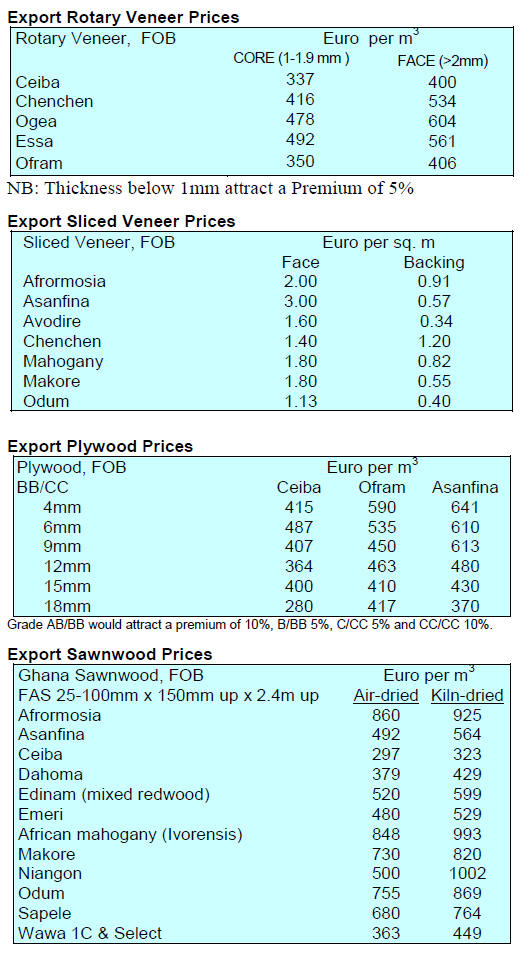
3.
SOUTH AFRICA
Wood trusses dominate market in
coastal regions
As a follow-up to the news in our previous report on the
truss market, steel trusses are only a major competitor to
the traditional wooden truss in inland areas away from the
salt laden sea air which corrodes steel trusses. But
competition from steel trusses has been a factor in the
Gauteng market for a while and it is estimated that some
30% of the trusses used in that area now steel.
Low cost housing is a big market in South Africa but here
pole trusses are common utilising plantation eucalyptus.
Low cost homes are generally roofed with simple
corrugated iron and there is no need for major load bearing
trusses.
Some manufacturers have experimented with trusses of
sawn eucalyptus but these have not gained acceptance as
they are much heavier than pine trusses and eucalyptus is
tough to treat against fungal and insect attack.
Demand and stronger rand helps lift US hardwood
imports
At present the pine market is very buoyant and pine
sawmillers succeeded in getting a 5-7% price increase in
early October. This was helped along by the low pine
sawn stocks at the mills.
The market for American hardwoods is also robust driven
by the high level of shop fitting activity and the fact that
the rand has strengthened making imports cheaper.
MTC visits to assess falling meranti imports
Representatives of the Malaysian Timber Council were in
South Africa in early October and they expressed
disappointment on how the market for Malaysian
sawnwood has shrunk from about 130,000 cu.m in 2007 to
just 61,000 cu.m annually.
Part of the reason is that there have been some significant
company closures such as the recent collapse of Zikiza and
there has been a strong performance of steel and aluminum
especially in the window market.
Local analysts also point to some negative trading issues
with Malaysian suppliers which have disappointed
importers such that they have shifted to other species such
as okoume where pricing and delivery is more predictable.
Another issue that has impacted meranti imports is the
move to pine and eucalyptus by door manufacturers.
Shipping disrupted as Hanjin goes down
The interest in sawnwood from SE Asia and even South
America has been affected by the insolvency of Hanjin
shipping which aggravated delivery problems as
containers were shut out.
Shipping problems are also affecting other products from
Asia such as plywood from China, but the new domestic
plymill at York is now in production so supplies are
adequate.
Housing crisis 每 bold new approaches needed
At a recent national human settlements conference at the
Nelson Mandela Metropolitan University in Port Elizabeth
Minister of Human Settlements, Lindiwe Sisulu, warned
that delivering on promises of good housing must be
delivered if further protests are to be avoided. The minister
urged academics and housing sector experts to offer
options for solving the housing crisis in South Africa.
A press release from her ministry says ※The inaugural
2016 National Human Settlements Conference represents
another step forward in our journey to professionalise and
elevate human settlements research, education and
practice.§
She further said ※there is a need for a change of mind set
from Housing to Human Settlements which demands a
systemic response by all stakeholders in the sector.
The current state of play in South Africa is to ensure
processes are in place to support professionalism and that
this will be backed up in legislation governing and
regulating human settlements practice in the country.§
For the press release see: http://www.gov.za/speeches/ministerhuman-
settlements-during-national-human-settlementsconference-
2016-6-oct-2016
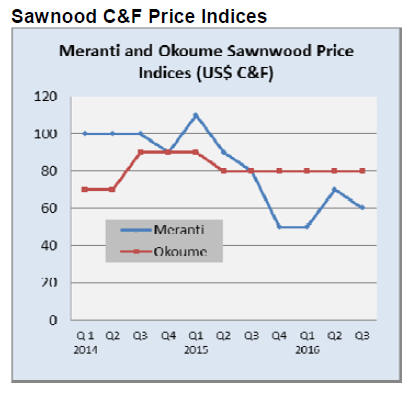
4.
MALAYSIA
Growth prospects to improve in 2017
The World Bank has slashed its 2016-18 growth forecast
for Malaysia due to the weakening global economy.
Malaysia*s GDP is now forecast to drop to 4.2% in 2016
from 5% last year.
However, the economy is set to rebound next year and
accelerate in 2018 as commodity prices are likely to rise
and there should be a boost in the export of manufactured
products.
In its newly released report ※Reducing Vulnerabilities§ the
Bank said growth across East Asia and Pacific is expected
to remain resilient over the next three years.
Malaysia*s exports rise
Malaysia*s exports rose 1.5% to RM67.58bil in August
from a year ago, far removed from the decline forecast by
economists.
Malaysia*s International Trade and Industry Ministry
(MITI) said in a press release that compared to July*s
exports of RM59.85bil, exports rose 12.9% to RM67.58bil
in August driven higher by a strong performance in the
Singapore, China and US markets.
2017 Malaysian International Furniture Fair (MIFF)
MIFF 2017 is scheduled for March 8 to 11 and this will be
the 23rd MIFF show. MIFF 2016 was a success for
domestic and overseas exhibitors with orders topping
RM3.7 billion.Already bookings for 2017 are pouring in
say the organisers and discussions are underway with a
view to offering even greater space for exhibitors.
For more see: http://2017.miff.com.my/
Sarawak log production dips
The latest statistics released by the Sarawak Forest
Department show log production for the first eight months
totalled 4,970,365 cu m. For the same period last year
production was 7% higher at5,345,604 cu.m.
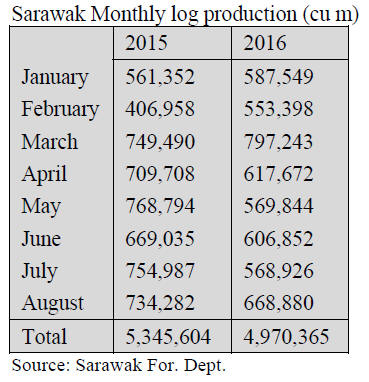
Between January and August this year Sarawak
exported
1,748,518 cu.m of logs worth RM1,030,227,350. India
was the biggest export market taking 913,094 cu.m (worth
RM715,346,043) in the same period.
Indonesia was the second biggest export market for
Sarawak logs taking 565,072 cu m (worth
RM110,617,778). Taiwan P.o.C was third ranked at
125,539 cu.m (RM102,523,384) followed by Vietnam,
80,838 cu.m (RM50,793,852).
Support for SMEs marketing in Europe and Middle
East
Malaysia*s External Trade Development Corporation*s
(MATRADE) has reported that a recent mission to
London generated potential sales of RM345 million
reflecting the strong trade ties between Malaysia and the
UK.
The recent event included a wide range of Malaysian
manufacturers including some from the building materials
sector. During the event in London a Memorandum of
Understanding (MoU) between SME International Trade
Association (SMITA) and Finpoint Limited was signed
aimed at funding assistance for SMEs marketing in the
UK, Europe and the Middle East.
For more see: http://www.matrade.gov.my/en/aboutmatrade/
media/press-releases/press-releases-2016/4974-
malaysian-companies-strenghten-foothold-in-the-unitedkingdom-
4-october-2016
5. INDONESIA
New forest management programme launched
A statement released in early October by Siti Nurbaya, the
Minister of Environment and Forestry, provides some
details of a new initiative to strengthen forest management
and at the same time provide opportunities for
communities living in forested areas.
A five year Sustainable Community-Based Natural
Resource Management and Institutional Development
Project is being financially assisted by the World Bank
and the Danish International Development Agency.
Integrating forest management and landscape
restoration
IUCN and World Resources Institute (WRI) Indonesia
recently arranged a workshop to introduce an Indonesian
version of a forest landscape restoration manual developed
in cooperation with the Ministry of Environment and
Forestry.
This, says a press release from IUCN, is a practical guide
for forest landscape restoration practitioners seeking to
develop programmes and landscape-level strategies.
At the workshop, WRI Indonesia*s Director Dr. Nirarta
Samadhi and Director of Watershed Management
Planning and Evaluation at the Ministry of Environment
and Forestry, Ir. Djati Witjaksono Hadi, stressed that there
are serious threats to the sustainability of Indonesia*s
forests and forest communities which create the need for
an integrated landscape approach.
For more see: https://www.iucn.org/news/indonesia-forestlandscape-
restoration-manual-launched
Indonesia*s wood products on show in Czech Republic
Minister for Regional Development in the Czech
Republic, Karla Slechtova, who recently visited Indonesia
expressed appreciation for Indonesia's participation in the
exhibition ForArch.
ForArch, held at the PVA EXPO PRAGUE Exhibition
Centre in late September, brought together over 800
exhibitors 67 of which were foreign.
When visiting Indonesia recently the Czech Minister of
Regional Development, Karla Slechtova, said he was
delighted to see Indonesia's participation in the exhibition
and expects this to lead to fruitful business developments
For more on ForArch see:
http://forarch.cz/file/show?nl_id=20676
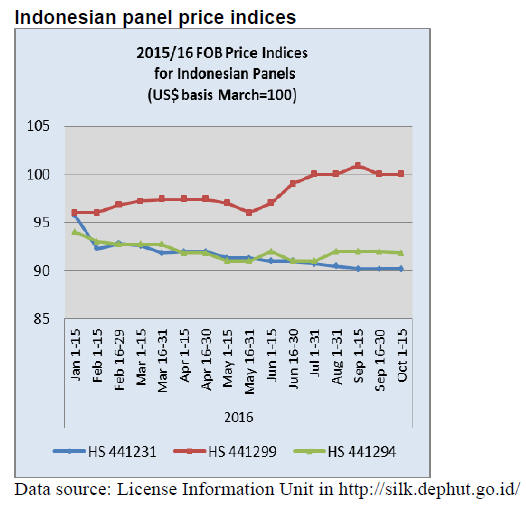
6. MYANMAR
Two tier log pricing creates problems
It has been announced that the Forestry Department will
no longer allow the export of wood products if they have
been manufactured from the logs sold by the Myanma
Timber Enterprise (MTE) in local currency as products
from these logs ca only be marketed locally.
After the log export ban in Myanmar the MTE decided to
have two different arrangements for its sale of logs. Those
for milling to meet domestic demand are priced in Kyat
while logs sold to millers for processing into products for
export are priced in US$.
The Local Marketing and Milling Department of MTE has
already sold a considerable volume of teak and hardwoods
logs in local currency. At the same time Export Marketing
and Milling Department of MTE continues to sell logs for
foreign currency.
As log stocks fell due to the suspension of logging exportoriented
mills could not get sufficient logs so began
diverting logs purchased in Kyat to export production this
caused a considerable conflict.
The MTE has managed to survive financially through
income earned from log sales, especially those priced in
Kyat, but the decision to stop the export of products milled
from logs allocated for domestic demand could hurt the
MTE financially.
All rosewoods now CITES listed
At the latest CITES meeting a decision was passed to
place an entire genus of plants, Dalbergia, covering over
300 species in Appendix II of the CITES convention
meaning only controlled trade in sustainable volumes will
be allowed. This is an effort to end the ploy by those
trafficking rosewood to pass off illegally sourced species
as legitimate.
Myanmar is a major source of rosewood. One of the most
sought after species which illegally finds its way onto
international markets is Tamalan (Dalbergia spp ), this is
now listed by CITES.
For more see:
https://cites.org/eng/news/pr/Largest_ever_World_Wildlif
e_Conference_CoP17_hailed_as_a_game_changer_04102
016
https://www.theguardian.com/environment/blog/2016/oct/
05/the-seven-big-decisions-made-at-the-cites-globalwildlife-
summit
https://www.theguardian.com/environment/2016/sep/29/w
ildlife-summit-cracks-down-on-illegal-rosewood-trade
7.
INDIA
Timber faces competition in Indian door
and window
market
Ken Research has published an assessment of the door and
window market in India focusing on the opportunities for
uPVC products as against traditional wood products.
The market review ※India uPVC Doors and Windows
Market Outlook to 2020 每 Growth in Residential
Apartments and Development of Smart Cities to Drive the
Future§ provides an analysis of various aspects such as the
size of the uPVC doors and windows market,
segmentation on the basis of type of products, regional
distribution, endues sectors and discusses competition in
the market.
Ken Research says ※The report is useful for industry
consultants and analysts, company managers and owners
and new players venturing in the market.§
For more see:
https://www.kenresearch.com/productsearch.html?searchKey=In
dia+uPVC+Doors+and+Windows+Market+Outlook+to+2020+-
+Growth+in+Residential+Apartments+and+Development+of+S
mart+Cities+to+Drive+Future+++&searchbyKey=
Life style expectations drive market for small
apartments
Many young couples in India face a tough decision when
it comes to home buying, do they commit a large part of
the disposable income on a family home or look for
something smaller and thereby maintain their life style?
For many young couples small apartments and even studio
apartments, basically one living/dining/kitchen room and a
bathroom, are becoming more attractive and sell very
quickly compared to the traditional 2 or 3 bedroom family
home. This trend has implications for home furnishing
manufacturers.
Andhra Pradesh eyes timber clusters to attract
shippers to local ports
Timber companies close to Kandla Port have developed
business clusters around the huge volume of timber which
enters India through the port and now the Andhra Pradesh
government wants to mimic this success and is drawing up
plans to try and attract shippers to use ports in the state.
As a first step to attracting a greater volume of timber
imports through Visakhapatnam, Krishnapatnam and other
local seaports, State authorities are urging the central
government to provide guidelines on the development of
processing clusters and to provide authority to the state to
permit the development of timber clusters close to ports in
Andhra Pradesh.
Strategic development of East Cost gets boost from
ADB funding
The Asian Development Bank (ADB) is providing a
package of loans and grants to support part of India*s
planned East Coast Economic Corridor (ECEC) that, on
completion, will create efficient infrastructure for
expanded trade links with South and Southeast Asian
countries.
The ADB says ※The Visakhapatnam-Chennai Industrial
Corridor section of the East Coast Economic Corridor,
connecting four economic hubs and nine industrial
clusters, will mark the first industrial corridor developed
along India*s coast.
The East Coast Economic Corridor will ultimately extend
from Kolkata in West Bengal in the northeast of India to
Tuticorin in Tamil Nadu near the southern-most point of
the country.§
See:
https://www.adb.org/news/adb-approves-funds-build-india-sfirst-
coastal-industrial-corridor
Inflation rate trends
The Office of the Economic Adviser (OEA) to the Indian
government provides trends in the Wholesale Price Index
(WPI).
The official Wholesale Price Index (WPI) for All
Commodities (Base: 2004-05=100) for August declined by
0.4 percent to 183.1 from 183.9 for July. The annual rate
of inflation, based on the monthly WPI, stood at 3.74%
(provisional) for the month of August, 2016 (over August,
2015).
See:
http://eaindustry.nic.in/cmonthly.pdf
Timber and plywood price indices climb
The OEA also reports Wholesale Price Indices for a
variety of wood products. The Wholesale Price Indices for
Wood products and Plywood are shown below.

Plantation teak prices
As domestic teak log auctions were suspended due to the
monsoon, demand for imported plantation teak picked up.

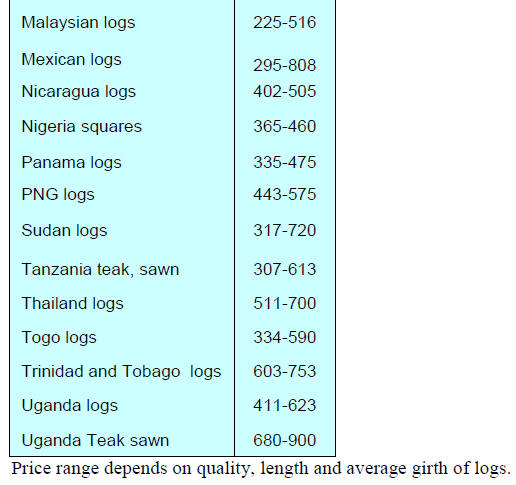
Prices from the three new plantation teak log
suppliers
remain unchanged at:Taiwan P.o.C (US$1036 to 2126 per
cu.m C and F), China (US$855 to 1118 per cu.m C and F)
and Honduras (US$471 to US$539 per cu.m C and F).
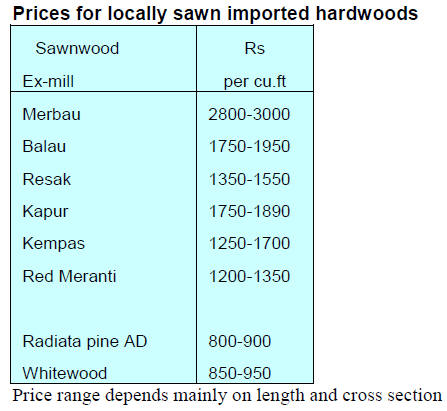
Myanmar teak flitches resawn in India
Domestic demand continues to firm but the steady supply
of sawn teak from Myanmar has stabilised prices.

Prices for imported sawnwood
Demand for imported sawnwood remains weak.
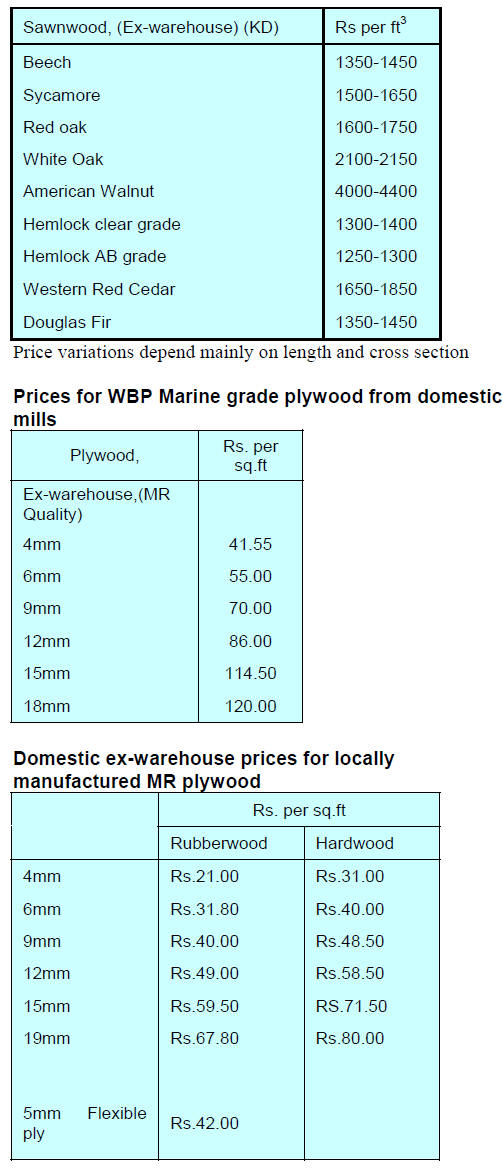
8.
BRAZIL
Door manufacturers bet on quality to
boost sales
Wooden door manufacturers are having a tough time in the
domestic market as activity in the building sector remains
very subdued, as it has been since 2012.
To try a boost local sales major domestic manufacturers
have been investing in production of higher quality
products.
Through the &Sectoral Quality Program for Wooden Doors
for Buildings* (PSQ-PME), developed by the Brazilian
Association of Mechanically-Processed Timber Industry
(ABIMCI), entrepreneurs are working to influence
consumer preferences towards higher quality doors.
Wooden door manufacturers say the PSQ-PME guarantees
the quality as products must meet high technical standards.
The PSQ-PME programme aims to promote competitive
equality among manufacturers through technical
conformity, encourage continuous improvement and high
added value branding.
Bureaucracy in importing countries hinder exports
Comex do Brasil, in an October report, says that nearly
32% of exporters surveyed by the Brazilian National
Confederation of Industry (CNI) say administrative and
customs bureaucracy in overseas markets, along with
import duties, are the main obstacles faced when trying to
boost exports from Brazil.
The CNI survey says 20% of exporters consider sanitary
and phytosanitary measures a major obstacle to be
overcome. Other non-tariff barriers, technical standards,
rules of origin and import quotas were listed by 17% of
exporters.
The impact of shipping costs was stated as a significant
issue for the pulp and paper sectors. Exporters reported
that wood products face a number of non-tariff barriers in
export markets.
The main obstacles to access foreign markets identified by
the CNI survey were as follows:
Administrative bureaucracy (37%)
Import customs bureaucracy (36%)
Import tariffs (32%)
Sanitary and phytosanitary measures (20%)
Subsidies that undermine competition (17%)
Technical standards (16%)
Rules of origin (13%)
Federal government reports on programmes to boost
export
The Ministry of Development Industry and Foreign Trade
(MDIC) has an ongoing National Plan for Exports (PNCE)
and a programme ※Brazil More Productive§. The aim is to
boost exports as Brazilian products are under-represented
in international trade.
The PNCE programme aims to increase the number of
companies operating in foreign markets, to promote the
export of goods and services with an emphasis on high
added value manufactured goods.
The programme includes three main themes, financing,
qualification and management and operates at five levels,
raising the awareness of domestic enterprises, improving
business intelligence, process and product adaptation and
trade promotion and marketing.
The ※Brazil More Productive§ programme is aimed at
small and medium companies and the goal is to improve
productivity by 20% during the term of the programme.
The pilot phase of this programme started in 2015 and by
way of example a furniture manufacturer/exporter has seen
significant improvements in productivity with worker
output rising over 70% and raw material use in packaging
falling over 35%.

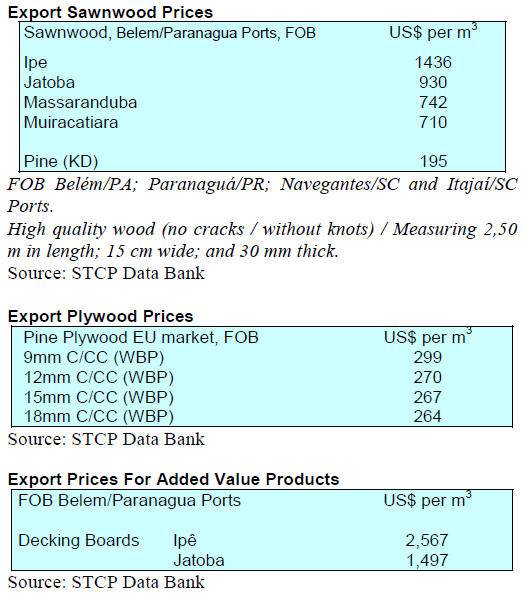
9. PERU
New Executive Director for SERFOR
The Ministry of Agriculture and Irrigation (Minagri) has
accepted the resignation of Fabiola Muñoz from the
position of Executive Director of the National Forest and
Wildlife Service (SERFOR). Mr. Muñoz was appointed to
this post in July 2014. He leaves as it was announced that
deforestation rates in Peru have fallen significantly.
The new Executive Director will be John James Leigh
Vetter, a forest engineer from the Agrarian University La
Molina. Mr Leigh has held posts in several international
bodies including the International Tropical Timber
Organization (ITTO) and has a wide experience in the
sustainable development of forest resources.
ADEX - Extend trade agreements to boost nontraditional
sectors
The President of the Association of Exporters (ADEX),
Juan Varilias, has emphasized the importance of
implementing policies to promote sectors with export
potential such as aquaculture, wood and forest products,
non-metallic mining and biological resources.
Varilias said to achieve expanded trade with countries
with which it has trade agreements it is necessary to
review laws on investment promotion.
He further said "The nature of the problems facing nontraditional
exports will demand a set of policies aimed at
improving the conditions that generate a competitive
environment and a policy for active promotion in
international markets.
In addition, further investment in transport infrastructure,
reform of public institutions responsible for foreign trade
and the strengthening incentives for innovation are key.§
Recently, ADEX signed an agreement with the China
Council for the Promotion of International Trade to jointly
generate business and investment opportunities to
strengthen development of economic and trade relations
between the two countries.
